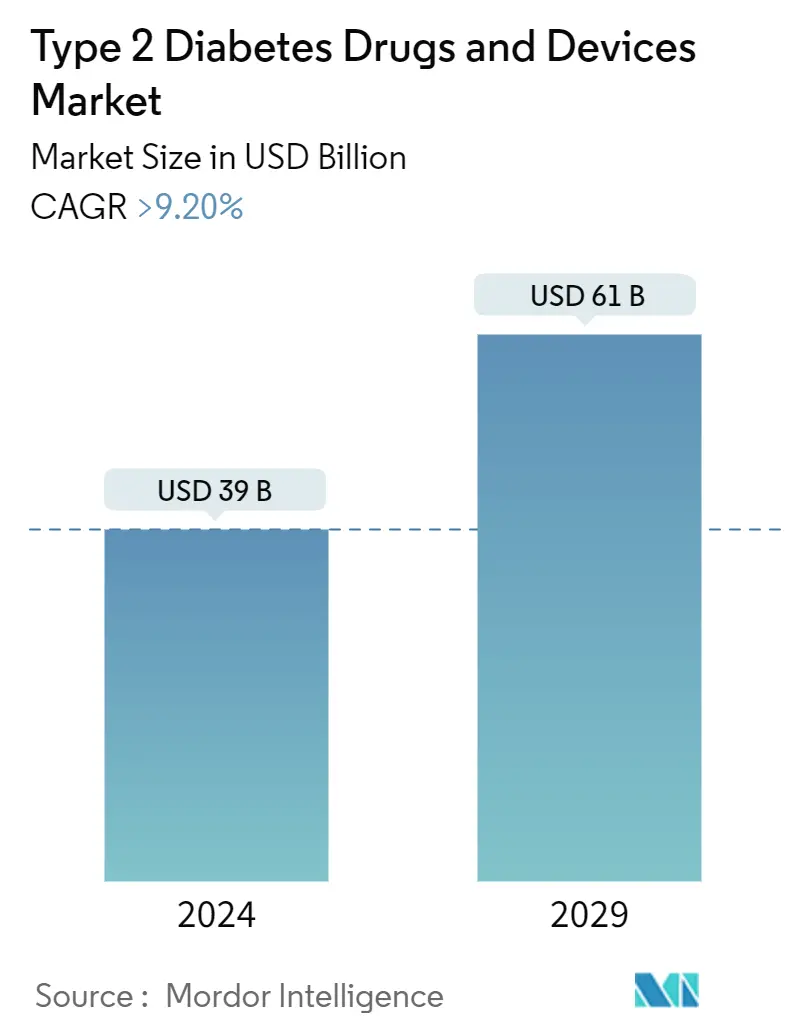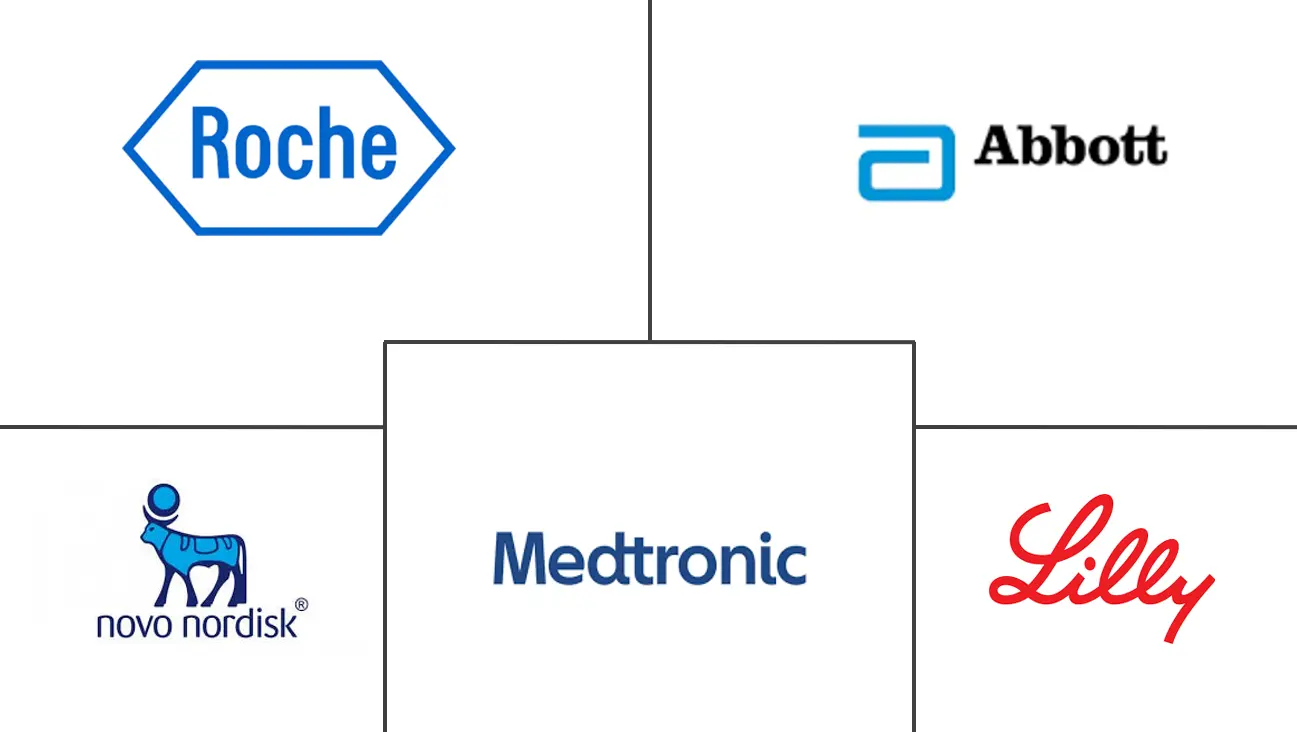Market Size of Type 2 Diabetes Drugs And Devices Industry

| Study Period | 2018-2029 |
| Market Size (2024) | USD 39 Billion |
| Market Size (2029) | USD 61 Billion |
| CAGR (2024 - 2029) | > 9.20 % |
| Fastest Growing Market | Asia Pacific |
| Largest Market | North America |
| Market Concentration | Low |
Major Players
*Disclaimer: Major Players sorted in no particular order |
Type 2 Diabetes Drugs And Devices Market Analysis
The Type 2 Diabetes Drugs And Devices Market size is estimated at USD 39 billion in 2024, and is expected to reach USD 61 billion by 2029, growing at a CAGR of greater than 9.20% during the forecast period (2024-2029).
People with diabetes mellitus had a greater risk of contracting COVID-19 infection. Type 2 diabetes mellitus patients had increased chances of pulmonary damage following SARS-COV-2 infection. The hyperglycemic state was an important prognostic factor in diabetic patients exposed to SARS-CoV-2. The increased severity was associated with chronic inflammation and immune system impairment in patients with Type 2 diabetes. Therefore, there was an urgent need to control elevated blood glucose control by proper monitoring and management to avoid any complications. Thus, the market continued to grow during the pandemic, offset by supply chain issues due to lockdown restrictions in various countries around the world.
Insulin is a hormone that controls blood sugar levels by signaling the liver muscle and fat cells to take in glucose from the blood. It helps cells take in glucose to be used for energy. Type 2 diabetes develops when the body does not use insulin efficiently and gradually loses the ability to make enough insulin. In type 2 diabetes, the body’s cells do not respond effectively to insulin, known as insulin resistance, which causes glucose to stay in the blood, leading to a higher-than-normal level of glucose in the blood, known as hyperglycemia.
Type 2 diabetes is a global burden disease and one of the leading causes of cardiovascular complications, which has led to the development of treatment approach options beyond insulin that also provide beneficial cardiovascular effects. The pharmacological approach has progressed from biguanides to a wide spectrum of medications that provide an additional beneficial effect. Various manufacturers are working on bringing novel antidiabetic drug classes capable of acting on several levels simultaneously.
Furthermore, various government and non-government initiatives are being launched to support patients with type 2 diabetes, which are likely to improve the awareness of patients with diabetes and, subsequently, the adoption of treatment for diabetes. For instance, the American Association of Clinical Endocrinology launched a Consensus Statement in May 2023 on a comprehensive type 2 Diabetes Management Algorithm that provides concise visual guidance in the form of algorithms to assist with clinical decision-making for the management of persons with type 2 diabetes mellitus and related comorbidities and complications. It incorporates newer therapies and management approaches that build on previous versions of the algorithm. These factors are expected to boost the market studied.
Type 2 Diabetes Drugs And Devices Industry Segmentation
Type 2 diabetes is a condition that causes the level of sugar in the blood to become too high. The Type 2 diabetes drugs and devices market is segmented into management devices (insulin pumps, insulin syringes, insulin cartridges, disposable pens, and jet injectors), monitoring devices (self-monitoring blood glucose and continuous glucose monitoring), drugs (insulin, oral anti-diabetic drugs, non-insulin injectable drugs, and combination drugs), and geography (North America, Europe, Asia-Pacific, the Middle East and Africa, and Latin America). The report offers the value (in USD) and volume (in units) for the above segments.
| Management Devices | |
| Insulin Pumps | |
| Insulin Syringes | |
| Insulin Cartridges | |
| Disposable Pens | |
| Jet Injectors |
| Monitoring Devices | |
| Self-monitoring Blood Glucose | |
| Continuous Glucose Monitoring |
| Drugs | |
| Oral Anti-diabetic Drugs | |
| Insulins | |
| Combination drugs | |
| Non-Insulin Injectable drugs |
| Geography | |||||||||||||
| |||||||||||||
| |||||||||||||
| |||||||||||||
| |||||||||||||
|
Type 2 Diabetes Drugs And Devices Market Size Summary
The Type 2 Diabetes Drugs and Devices Market is poised for significant growth over the forecast period, driven by the increasing prevalence of diabetes globally and the urgent need for effective management solutions. The market is characterized by a diverse range of pharmacological treatments and devices aimed at controlling blood glucose levels and mitigating complications associated with the disease. The development of novel antidiabetic drug classes and the introduction of advanced monitoring devices are key trends shaping the market landscape. Government and non-government initiatives, such as the American Association of Clinical Endocrinology's comprehensive management algorithms, are enhancing patient awareness and treatment adoption, further propelling market expansion. The market's resilience during the COVID-19 pandemic, despite supply chain challenges, underscores the critical demand for diabetes management solutions.
In regions like Asia-Pacific, the market is experiencing robust growth due to the rising diabetic population, particularly in countries like India and China. These markets present both opportunities and challenges, including economic factors and increased competition. The region's focus on cost-effective treatments and the rise of generic manufacturers are contributing to market dynamics. Major players such as Eli Lilly, Sanofi, Novo Nordisk, and AstraZeneca are actively engaging in product launches and technological collaborations to strengthen their market presence. Additionally, strategic partnerships, like the one between Astellas Pharma and Roche Diabetes Care, highlight the ongoing efforts to innovate and expand the availability of diabetes management solutions. The market's fragmented nature and the supportive regulatory environment further facilitate the introduction of new products and technologies, ensuring continued growth and development in the coming years.
Type 2 Diabetes Drugs And Devices Market Size - Table of Contents
-
1. MARKET DYNAMICS
-
1.1 Market Overview
-
1.2 Market Drivers
-
1.3 Market Restraints
-
1.4 Porter's Five Forces Analysis
-
1.4.1 Bargaining Power of Suppliers
-
1.4.2 Bargaining Power of Consumers
-
1.4.3 Threat of New Entrants
-
1.4.4 Threat of Substitute Products and Services
-
1.4.5 Intensity of Competitive Rivalry
-
-
-
2. MARKET SEGMENTATION
-
2.1 Management Devices
-
2.1.1 Insulin Pumps
-
2.1.2 Insulin Syringes
-
2.1.3 Insulin Cartridges
-
2.1.4 Disposable Pens
-
2.1.5 Jet Injectors
-
-
2.2 Monitoring Devices
-
2.2.1 Self-monitoring Blood Glucose
-
2.2.2 Continuous Glucose Monitoring
-
-
2.3 Drugs
-
2.3.1 Oral Anti-diabetic Drugs
-
2.3.2 Insulins
-
2.3.3 Combination drugs
-
2.3.4 Non-Insulin Injectable drugs
-
-
2.4 Geography
-
2.4.1 North America
-
2.4.1.1 United States
-
2.4.1.2 Canada
-
2.4.1.3 Rest of North America
-
-
2.4.2 Europe
-
2.4.2.1 France
-
2.4.2.2 Germany
-
2.4.2.3 Italy
-
2.4.2.4 Spain
-
2.4.2.5 United Kingdom
-
2.4.2.6 Russia
-
2.4.2.7 Rest of Europe
-
-
2.4.3 Latin America
-
2.4.3.1 Mexico
-
2.4.3.2 Brazil
-
2.4.3.3 Rest of Latin America
-
-
2.4.4 Asia-Pacific
-
2.4.4.1 Japan
-
2.4.4.2 South Korea
-
2.4.4.3 China
-
2.4.4.4 India
-
2.4.4.5 Australia
-
2.4.4.6 Vietnam
-
2.4.4.7 Malaysia
-
2.4.4.8 Indonesia
-
2.4.4.9 Philippines
-
2.4.4.10 Thailand
-
2.4.4.11 Rest of Asia-Pacific
-
-
2.4.5 Middle East and Africa
-
2.4.5.1 Saudi Arabia
-
2.4.5.2 Iran
-
2.4.5.3 Egypt
-
2.4.5.4 Oman
-
2.4.5.5 South Africa
-
2.4.5.6 Rest of Middle East and Africa
-
-
-
Type 2 Diabetes Drugs And Devices Market Size FAQs
How big is the Type 2 Diabetes Drugs And Devices Market?
The Type 2 Diabetes Drugs And Devices Market size is expected to reach USD 39 billion in 2024 and grow at a CAGR of greater than 9.20% to reach USD 61 billion by 2029.
What is the current Type 2 Diabetes Drugs And Devices Market size?
In 2024, the Type 2 Diabetes Drugs And Devices Market size is expected to reach USD 39 billion.

